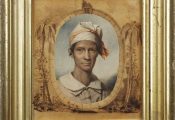This image was produced by Thomas Picken (1815-70), and was published by R. Cartwright, London in 1838.
It shows the Governor of Jamaica, Sir Lionel Smith (1778-1842) on the steps of Government House in Spanish Town, Jamaica reading the proclamation of freedom that marked the emancipation of the slaves in Jamaica. The event is presented as a joyous occasion, attended by deeply religious people. The Baptist church was particularly important. It provided a forum in which abolition could be advanced. Some White Baptist ministers, like J.M. Phillipo, advocated abolition and emancipation to the planter class on behalf of their Black congregations.
The caption below the text reads: ‘Procession of the Baptist church and congregation in Spanish Town under the pastoral care of the Revd. J.M. Phillipo, with about 2000 children of their schools and their teachers, to the Government House on the 1st August 1838 – when they were received by His Excellency the Governor Sir Lionel Smith who after addressing them, read to them the proclamation of freedom, amidst the hearty rejoicing of not less than 8000 persons, the majority of whom had previously attended divine worship, and who subsequently retired to their respective homes peaceful and happy – The Governor – The Revd. J.M. Phillipo and the Bishop are seen standing in front of the portico thus representing the happy union of civil & religious feeling on this joyful occasion.’
© National Maritime Museum, Greenwich, UK
Accession reference: National Maritime Museum, ZBA2725


